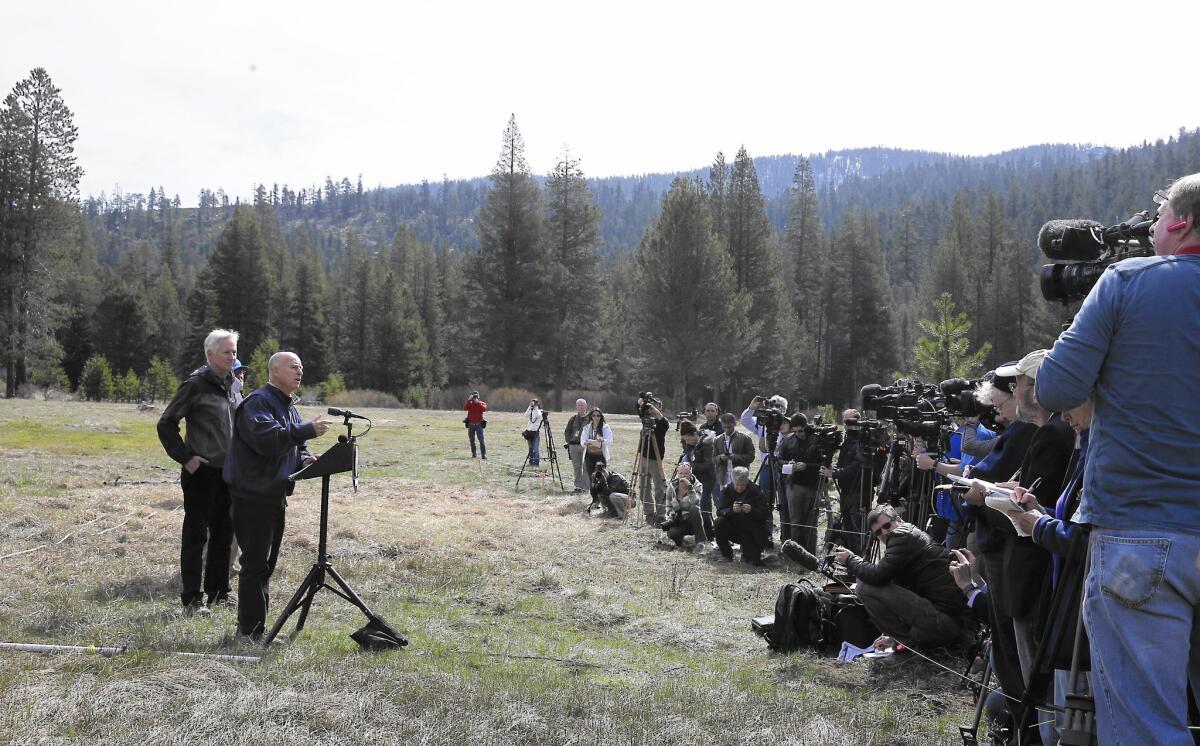Drought will prove a formidable opponent in Brown’s final term

Gov. Jerry Brown talks to reporters in Echo Summit, Calif., about his new executive order mandating cities and towns to cut water usage by 25%.
During the drive from the Capitol to Lake Tahoe this week, Gov. Jerry Brown could see the damage wrought by four years of drought. Rivers have turned to dribbles, parched forests threaten to ignite with a fateful spark, and meadows where snow should be piled high are instead completely bare.
When Brown stepped out of the car, he made history by announcing the first statewide mandatory water restrictions, ordering Californians to slash their water use by 25%.
It wasn’t the way he intended to make his mark in his final term as governor, but Mother Nature had other plans. With no relief from the drought in sight, his most critical tasks will be rallying Californians to conserve water, navigating the state’s fractious water politics and preparing for what could be a much drier future in America’s most productive agricultural region.
“It’s going to require every ounce and every moment of his political attention and his political skill,” said Sonoma State political science professor David McCuan.
The governor also is dealing with stark regional differences, and the drought threatens to inflame an urban-rural divide in California. Conservationists have already raised concerns that Brown isn’t doing enough to curb agricultural water use, which accounts for 80% of the state’s total.
“This is not going to be the kind of coalition that’s going to be easily built,” said Raphael J. Sonenshein, executive director of the Pat Brown Institute of Public Affairs at Cal State L.A.
Brown has faced drought before: There was a two-year dry spell in 1976 and 1977 when he was governor the first time. But that lasted only half as long as the current drought, and it didn’t lead to the same mandatory restrictions on water use.
In addition to those limits, Brown’s executive order includes stricter enforcement and the removal of 50 million square feet of lawns.
“We’re in a historic drought, and that demands unprecedented action,” he told reporters Wednesday. “People should realize we’re in a new era. The idea of your nice little green grass getting water every day — that’s going to be a thing of the past.”
Brown is determined to manage the drought while pursuing other goals such as building the bullet train and expanding renewable energy generation — “government is not just one thing,” he said.
But there’s no doubt that he faces a heavy burden in the months and years ahead.
Mark Cowin, director of the California Department of Water Resources, said administration officials were working out details with the governor late into the night before the announcement.
Brown had asked residents last year to cut water use by 20%, but they consistently fell short even as the drought persisted. When February conservation statistics continued to lag, officials said, it drove home the need for a more restrictive approach.
In addition, snow in the Sierra Nevada, which usually provides a third of California’s water when it melts in the spring, has been nearly nonexistent.
“Considering the potential for a fifth or sixth year of drought, we want to start pulling up the stick of the plane so we don’t have a crash landing,” Cowin said.
Brown will need Californians’ cooperation to save water, and it appears that residents are increasingly aware of the drought’s toll. A March survey by the Public Policy Institute of California showed that water issues have become as important in voters’ minds as jobs and the economy. Two-thirds of respondents said water supply is a big problem in their area and more should be done to respond to the drought.
“It’s been frustrating that it’s taken this long to get on the public’s radar,” said Annie Notthoff, director of California advocacy for the Natural Resources Defense Council. “But now people are starting to see this is not business as usual.”
The governor said Wednesday that he’s trying to do his part by “turning off that faucet a little quicker, getting out of the shower a little faster, not flushing the toilet every time.”
Pushing for water conservation is nothing new for Brown, who has railed against environmental dangers throughout his political career. He battled Los Angeles smog in the 1970s, ran for president in 1980 by promising to “protect the Earth” and has since traveled the world to urge action on climate change.
“He has always said, right from the start, we have to pay attention to environmental impacts, that natural resources are not unlimited,” said Bruce Cain, professor of political science at Stanford University. “These are Jerry Brown’s themes.”
Given Brown’s record, Cain said, the drought is “in his wheelhouse.”
But Cain and other analysts warned that the problem could quickly grow time-consuming and politically treacherous. Implementing Brown’s executive order will require new and extensive regulations and careful monitoring of thousands of local water agencies to ensure restrictions are being enforced.
Even while Brown faces the short-term consequences of the drought — including the potential for budget-draining wildfires and decreased agricultural production — he is pursuing long-term projects that he says will strengthen California’s highly engineered water systems.
The most controversial is his proposal to dig two massive tunnels under the Sacramento-San Joaquin River Delta to send water from Northern California to farms and cities farther south.
Richard Frank, director of the California Environmental Law and Policy Center at UC Davis, said the issue remains “the single toughest political nut to crack.”
“The status quo in the Delta is completely unsustainable,” with aging canals and ecological damage, he said. “But the consensus really ends there.”
chris.megerian@latimes.com
Twitter: @chrismegerian
More to Read
Start your day right
Sign up for Essential California for news, features and recommendations from the L.A. Times and beyond in your inbox six days a week.
You may occasionally receive promotional content from the Los Angeles Times.







